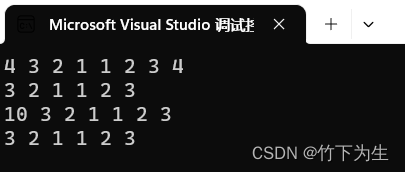list是带头双向循环链表
一、list的相关接口及其功能
1. 构造函数
| 函数声明 | 功能说明 |
| list(size_type n,const value_type& val=value_type()) | 构造的list中包含n个值为val的元素 |
| list() | 构造空的list |
| list(const list& x) | 拷贝构造 |
| list(InputIterator first, InputIterator last) | 用[fiirst,last)区间的元素构造list |
void test1()
{list<int> v;list<int> v1(5,2);list<int> v2(v1);list<int> v3(v1.begin(),v1.end());for (auto x : v)cout << x << " ";cout << endl;for (auto x : v1)cout << x << " ";cout << endl;for (auto x : v2)cout << x << " ";cout << endl;for (auto x : v3)cout << x << " ";cout << endl;}
2.list的迭代器
| 函数名称 | 功能名称 |
| begin()+end() | 获取第一个数据位置的iterator/const_iterator,获取最后一个数据的下一个位置的iterator/const_iterator |
| rbegin()+rend() | 获取第一个数据位置的reverse_iterator/const_reverse_iterator,获取最后一个数据的下一位置的reverse_iterator/const_reverse_iterator |

void test2()
{list<int> v;v.push_back(1);v.push_back(2);v.push_back(3);v.push_back(4);list<int>::iterator it = v.begin();//注意如果写类型名,那么一定要写正确,如加不加reverse、const一定要写对//如果不想写这么长的类型,可以写auto自动类型推导while (it != v.end()){cout << *it << " ";it++;}cout << endl;list<int>::reverse_iterator it1 = v.rbegin();while (it1 != v.rend()){cout << *it1 << " ";it1++;}cout << endl;
}
3.list的capacity
| 函数声明 | 功能介绍 |
| empty() | 检测list是否为空 |
| size() | 返回list中有效结点的个数 |
4.获取首尾元素
| 函数声明 | 功能介绍 |
| front | 返回list的第一个节点中值的引用 |
| back | 返回list的最后一个结点中值的引用 |
5.list的修改
| 函数名称 | 功能介绍 |
| push_front | 在list首元素前插入值为val的值 |
| pop_front | 删除list中第一个元素 |
| push_back | 在list尾部插入值为val的值 |
| pop_back | 删除list中的最后一个元素 |
| insert | 在list中pos位置插入值为val的元素 |
| erase | 删除list中pos位置的元素 |
| swap | 交换两个list中的元素 |
| clear | 清空list中的有效元素 |
void test3()
{list<int> v;v.push_back(1);v.push_back(2);v.push_back(3);v.push_back(4);v.push_front(1);v.push_front(2);v.push_front(3);v.push_front(4);for (auto x : v)cout << x << " ";cout << endl;v.pop_back();v.pop_front();for (auto x : v)cout << x << " ";cout << endl;v.insert(v.begin(),10);for (auto x : v)cout << x << " ";cout << endl;v.erase(v.begin());for (auto x : v)cout << x << " ";cout << endl;
}
6.list迭代器失效问题(重点)
在讲vector的博客中,我也提到了迭代器失效问题,那么问个问题,list的迭代器失效和vector的迭代器失效一样吗?为什么?
这里先解释一下什么是迭代器,估计有很多人对这个名词还不是很了解,其实所谓的迭代器从作用上来说就是访问遍历容器的工具,它将所有容器的访问遍历方式进行了统一(vector,list,set等等容器的迭代器使用几乎一摸一样都是begin(),end(),++/--等操作),封闭了底层的细节,简化了我们对容器的使用,对于初学者来说,这玩意tm的太神了,但是如果我们了解它的底层实现,我们就会发现,迭代器不过是一层封装,底层还是数据结构那一套,如list链表,迭代器的++,本质还是指针的变化。
(容器的底层实现还是要了解一些,能够帮助我们更好的认识和使用容器,可以看看我写过的一些模拟实现,如果有需要注释或者详解,请在评论区留言,如果需求多,我会单独出一篇博客讲解一下里面的一些重点内容)
好,下面回归正题,如果你数据结构学的还不错并且知道vector的迭代器失效是扩容引起的,那么这个问题不难回答,因为链表的增查改不会影响一个结点的位置,除了删除操作,所以list的迭代器失效仅仅只有在删除list结点时才会出现,并且只有那个被删除结点的迭代器会失效,其他的不受影响
二、模拟实现list的基本功能
namespace zjs
{template <class T>struct list_node {T _data;list_node<T>* _next;list_node<T>* _prev;list_node(const T& data = T()):_data(data),_next(nullptr),_prev(nullptr){}};//重点template <class T, class Ref, class Ptr >struct __list_iterator {typedef list_node<T> Node;typedef __list_iterator self;Node* node;__list_iterator(Node* x):node(x){}self& operator++(){node = node->_next;return *this;}self& operator--(){node = node->_prev;return *this;}self operator++(int){self tmp(*this);node = node->_next;return tmp;}self operator--(int){self tmp(*this);node = node->_prev;return tmp;}Ref operator*(){return node->_data;}bool operator==(const self& It) const{return node == It.node;}bool operator!=(const self& It) const{return node != It.node;}Ptr operator->(){return &node->_data;}};/*template <class T>struct __list_const_iterator {typedef list_node<T> Node;typedef __list_const_iterator self;Node* node;__list_const_iterator(Node* x):node(x){}self& operator++(){node = node->_next;return *this;}self& operator--(){node = node->_prev;return *this;}self operator++(int){self tmp(*this);node = node->_next;return tmp;}self operator--(int){self tmp(*this);node = node->_prev;return tmp;}const T& operator*() {return node->_data;}const T* operator->(){return &node->_data;}bool operator==(const self& It){return node == It.node;}bool operator!=(const self& It){return node != It.node;}};*/template <class T>class list{public:typedef list_node<T> Node;typedef __list_iterator<T, T&, T*> iterator;typedef __list_iterator<T,const T&,const T*> const_iterator;//typedef __list_const_iterator<T> const_iterator;void empty_init(){_head = new Node;_head->_next = _head;_head->_prev = _head;}list(){_size = 0;empty_init();}void clear(){iterator it = begin();while (it!=end()){it = erase(it);}}~list(){clear();delete _head;_head = nullptr;}list(const list<T>& tmp):_head(nullptr),_size(0){empty_init();for (auto& x : tmp){push_back(x);}}void swap(list& tmp){std::swap(_head, tmp._head);std::swap(_size, tmp._size);}list<T>& operator=(list<T> tmp){swap(tmp);return *this;}const_iterator begin() const{return _head->_next;}iterator begin(){//return iterator(_head->_next);return _head->_next;}const_iterator end() const{//return iterator(_head);return _head;}iterator end(){//return iterator(_head);return _head;}void push_back(const T& x){//Node* tail = _head->_prev;//Node* newnode = new Node(x);//tail->_next = newnode;//newnode->_prev = tail;//newnode->_next = _head;//_head->_prev = newnode;insert(end(), x);}void push_front(const T& x){insert(begin(), x);}iterator insert(iterator pos, const T& x){Node* cur = pos.node;Node* pre = cur->_prev;Node* newnode = new Node(x);pre->_next = newnode;newnode->_prev = pre;newnode->_next = cur;cur->_prev = newnode;_size++;return newnode;}void pop_back(){erase(--end());}void pop_front(){erase(begin());}iterator erase(iterator pos){Node* cur = pos.node;Node* pre = cur->_prev;Node* next = cur->_next;pre->_next = next;next->_prev = pre;delete cur;_size--;return next;}size_t size() const{return _size;}private:Node* _head;size_t _size;};//模板的一些应用,typename的用法//这里只能用typedef,用来告诉编辑器const_iterator是一个类型名,而不是一个静态变量//因为编辑器在编译阶段要判断有没有语法错误,而list<T>没有实例化,就无法在里面//查找const_iterator,而如果它是静态变量很显然这是个语法错误,//所以这里要加上typename告诉编辑器这是个类型名,等到实例化之后再去里面找template<typename T>void print_list(const list<T>& s){typename list<T>::const_iterator it = s.begin();while (it != s.end()){cout << *it << " ";++it;}cout << endl;}template<typename container>void print_container(const container& s){typename container::const_iterator it = s.begin();while (it != s.end()){cout << *it << " ";++it;}cout << endl;}}
![[FPGA IP系列] FPGA常用存储资源大全(RAM、ROM、CAM、SRAM、DRAM、FLASH)](http://pic.xiahunao.cn/[FPGA IP系列] FPGA常用存储资源大全(RAM、ROM、CAM、SRAM、DRAM、FLASH))








】)








